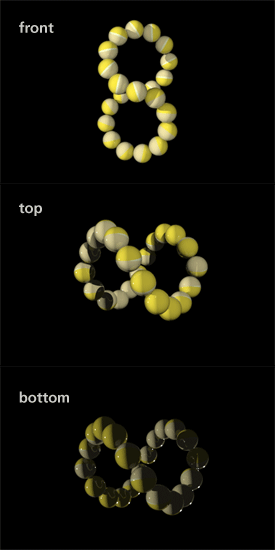Seen from the front the whole (8) rotates in one direction, but seen from the top and the bottom, the upper- and lower part phase shift 180°, creating two oposite fields. Imagine the rotation at a much higher constant speed and you get a polarised sphere.
At every point of the (8) there is an opposite rotation takes place. Look at the image above with the X:
• In the 1st setting the X goes in one direction, straight forward.
• In the 2nd setting the X rotates, the Up- and Downside of each leg (\-/) goes in an opposite direction. Notice the X isn't connected in the middle it are just two legs.
• When you connect both legs on the top and at the bottom, you create a (8) sphere with opposite poles.
On the other sketch each sphere (8) is a wind-up coil, and has a certain tension (density), and they all turn synchronous with the coil in-front and behind. When for example 20 spinning coils form an 8 and short-circuit, they wind each other up, increasing tension, and create a bigger new coil (8) but smaller in size than the sum of the original coils because tension is much higher. Think of a "snakebite" you know when you twist and turns somebodies underarm, and it burns, it's an increase of tension, like the clip below:
Conclusion: there are no 2 physical fields, but because of the formation of an (8) shpere and the rotation of it in one direction, two forcefields that phase shift 180° are created with as result a (+) and a (-) pole.
A more extended (8) sphere
This model could be a better theory for the behavior of particles. When particles collide and are splashed apart, they are stretched until the point that they split into newer smaller particles, or join with other particles, and form new particles of different sizes. It is a different approach than up - or down quarks in the quantum mechanics model. A good mathematic simulation could compare it to existing results of particle collisions.





